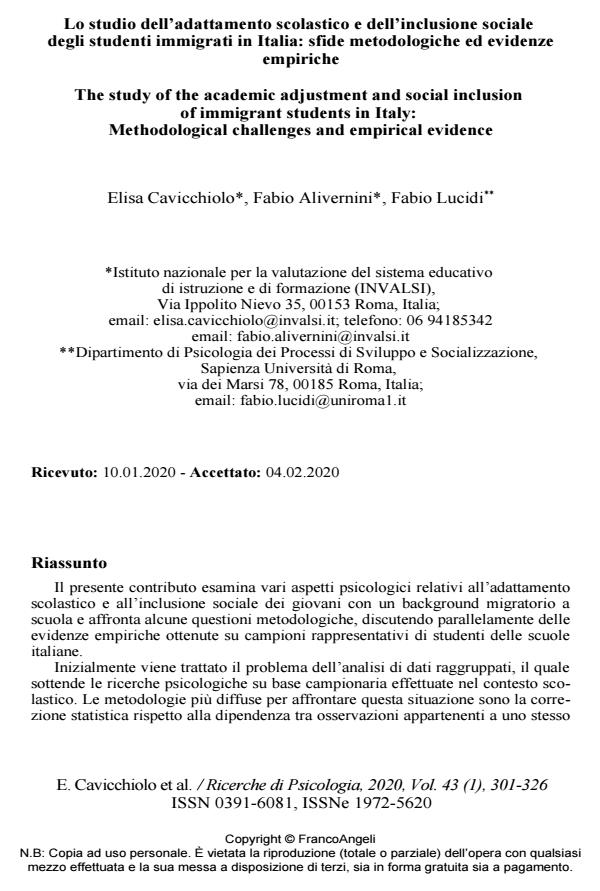The study of the academic adjustment and social inclusion of immigrant students in Italy: Methodological challenges and empirical evidence
Journal title RICERCHE DI PSICOLOGIA
Author/s Elisa Cavicchiolo, Fabio Alivernini, Fabio Lucidi
Publishing Year 2020 Issue 2020/1
Language Italian Pages 26 P. 301-326 File size 283 KB
DOI 10.3280/RIP2020-001014
DOI is like a bar code for intellectual property: to have more infomation
click here
Below, you can see the article first page
If you want to buy this article in PDF format, you can do it, following the instructions to buy download credits

FrancoAngeli is member of Publishers International Linking Association, Inc (PILA), a not-for-profit association which run the CrossRef service enabling links to and from online scholarly content.
This paper examines some psychological aspects of the academic adjustment and social inclusion of young people with an immigrant background at school, addressing some methodological issues and discussing the empirical evidence obtained from representative samples of students in Italy. Initially we examined methodologies related to the analysis of grouped data, with reference to procedures based on statistical correction and multilevel analysis. The choice of which approach is to be used should be based on the research questions, for example by clarifying whether they are asked at an individual or at a group level. Subsequently we considered the problem of conducting school investigations on sensitive issues, where an exclusive use of closed questions can be problematic. Instruments featuring open questions based on metaphors have, in this case, the advantage of allowing students to use their own words based on their personal experiences, making it possible to deal with delicate subjects indirectly. Evidence based on representative samples shows that, as regards academic adjustment, an immigrant pupil in primary school is, on average, more and better motivated regarding his/her activities at school than are his/her peers. At the same time, in secondary school, immigrant students use less self-regulated cognitive strategies. In both cases, first-generations show a more adaptive pattern than second- generations. As regards social inclusion, Italian studies show that in class an immigrant student has lower levels of peer acceptance and has less friends than native pupils. Moreover, he/she reports being victimized more frequently at school than other students. Second-generations are more socially included than first-generations suggesting an assimilation effect. Finally, as regards attitudes towards immigrants, Italian data show students’ perceptions that, from a cognitive and emotional perspective can’t be described simply using a positive/negative dichotomy.
Keywords: Clustered data, metaphors, academic adjustment, social inclusion, psychological well-being at school, attitudes towards immigrants.
- Migrazioni e psicologie. Introduzione al Forum Alessandro Antonietti, Antonella Marchetti, in RICERCHE DI PSICOLOGIA 1/2020 pp.13
DOI: 10.3280/RIP2020-001002
Elisa Cavicchiolo, Fabio Alivernini, Fabio Lucidi, Lo studio dell’adattamento scolastico e dell’inclusione sociale degli studenti immigrati in Italia: sfide metodologiche ed evidenze empiriche in "RICERCHE DI PSICOLOGIA " 1/2020, pp 301-326, DOI: 10.3280/RIP2020-001014